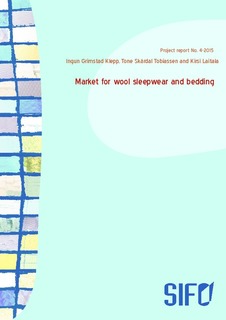| dc.description.abstract | The aim of this report is to give an overview of woolen sleepwear and bedding products that are available on the market. The analysis is made in three countries: Norway, Sweden and the UK. The work has been conducted by National Institute for Consumer Research (SIFO) and Nordic Initiative Clean & Ethical (NICE) for Australian Wool Innovation LtD (AWI).
The survey is based on market analysis of Internet searches. We used Google and searched for wool in various combinations with names for night-wear/clothing and bed linens. The searches were specified with language and location of the web store. The most relevant findings were recorded. We observed great differences between the three countries in types of products that were available, their customer groups, as well as market channels. The scope of the search was limited to next-to-skin products including nightwear and bedding, thus excluding products where the wool is used as filling material in mattresses, duvets or pillows. In Norway, the wool nightwear market for babies and toddlers is large and varied. Some nightwear, mainly nightgowns, is also available for women, but not for men. The Swedish market for wool sleepwear emerges as more "alternative" than the Norwegian. There was more emphasis on ideology, while the Norwegian market appears more mixed and more common. Similar to Norway, babies, children and women are the target markets for wool sleepwear. Sleepwear in the UK differs radically as nightwear seems to be a more important type of dress, and includes several types of garments such as bathrobes and leisurewear. We found wool mainly within the luxury segment for men. The garments were classic pajamas made of wool mixed with cotton or silk. This type of dress is very unusual in Norway and Sweden, where the sleepwear chosen by men is far less formal. The markets for next-to-skin bedding product in wool are more marginal and mainly found only in Norway and Sweden. While the market for sleepwear in wool is very similar to the market for cotton sleepwear (only more limited), what characterizes the market for bed linen in wool is a strict differentiation from the normal cotton-dominated market in Norway and Sweden. This applies to type of products, esthetics and sales channels, as well as product care. The products appear “natural” in white or brown, thick, and wooly. They are mainly sold as a type of health products within the alternative health market. In the UK, there were many different dealers selling “wool bed” but wool is used as filling material, not as next-to-skin products, so these were outside the scope of our study. | en |
